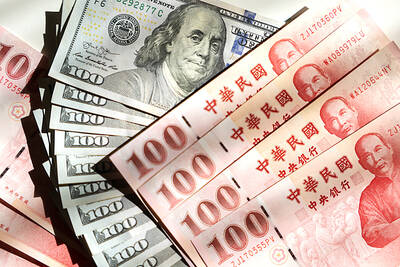Bullish global financial markets helped CTBC Financial Holding Co (中信金控) report a record-high net profit of NT$40.81 billion (US$1.34 billion) for the first 10 months of this year, or earnings per share (EPS) of NT$2.05, the company said yesterday.
That surpassed its previous high of NT$39.4 billion for the same period in 2014, when that number was largely due to CTBC Bank’s (中信銀行) acquisition of Tokyo Star Bank Ltd, corporate data showed.
While CTBC Financial hopes to achieve a record profit for the whole of this year, it is facing multiple challenges, company president Daniel Wu (吳一揆) told a media briefing in Taipei.
Given that Taiwanese and foreign stock markets have risen to comparatively high levels, they are likely to fall into a consolidation mode in the near term, Wu said.
In addition, the continuous interest rate cuts by central banks around the world have made it more difficult for insurers to achieve high investment returns, including CTBC’s insurance unit, Taiwan Life Insurance Co (台灣人壽), he said.
“Currently one-third of government bonds have negative yields, which I have never seen before in my life. The strange phenomenon that has yet to be explained by any textbook rationale concerns me, as it might imply high risks of recession,” the 59-year-old Wu said.
As the IMF and other global institutions have continued to trim their economic forecasts for next year, and with the US-China trade tensions likely to last, the US Federal Reserve is likely to cut its interest rate another time next year, he added.
The Directorate-General of Budget, Accounting and Statistics’ prediction that Taiwan next year might outperform this year to see an annual gain of 2.5 percent could come true if the government manages to have all the new investment applications materialize, Wu said.
CTBC hopes the exchange rate of New Taiwan dollar against the US dollar will remain in the NT$30 and NT$31 range, as a drastic appreciation of the currency would eclipse insurers’ profits, he said.
“Overall, we will be more cautious about our financial investment and do more risk monitoring,” he said.
In a bid to boost profitability, Taiwan Life in the first half of the year discontinued some policies denominated in NT dollars that had payment periods of less than five years, senior vice president Yeh Pai-hung (葉栢宏) said.
That came after the insurer stopped selling single-premium life policies last year, Yeh said.
As a result, its first-year premiums (FYP) for the first nine months of this year dropped 41.2 percent to NT$62.87 billion, and the full-year FYP is forecast to total NT$80 billion, down 24 percent annually, Wu said.
Despite the falling FYP, if Taiwan Life continues to sell products that promise high declared rates or returns for policyholders, it would need to take more risks in investment, he said.
“We no longer aim to boost FYP, but will put more focus on the profitability of policies. This will make our operations more sustainable,” he added.

MARKET LEADERSHIP: Investors are flocking to Nvidia, drawn by the company’s long-term fundamntals, dominant position in the AI sector, and pricing and margin power Two years after Nvidia Corp made history by becoming the first chipmaker to achieve a US$1 trillion market capitalization, an even more remarkable milestone is within its grasp: becoming the first company to reach US$4 trillion. After the emergence of China’s DeepSeek (深度求索) sent the stock plunging earlier this year and stoked concerns that outlays on artificial intelligence (AI) infrastructure were set to slow, Nvidia shares have rallied back to a record. The company’s biggest customers remain full steam ahead on spending, much of which is flowing to its computing systems. Microsoft Corp, Meta Platforms Inc, Amazon.com Inc and Alphabet Inc are

Luxury fashion powerhouse Prada SpA has acknowledged the ancient Indian roots of its new sandal design after the debut of the open-toe footwear sparked a furor among Indian artisans and politicians thousands of miles from the catwalk in Italy. Images from Prada’s fashion show in Milan last weekend showed models wearing leather sandals with a braided design that resembled handmade Kolhapuri slippers with designs dating back to the 12th century. A wave of criticism in the media and from lawmakers followed over the Italian brand’s lack of public acknowledgement of the Indian sandal design, which is named after a city in the

The US overtaking China as Taiwan’s top export destination could boost industrial development and wage growth, given the US is a high-income economy, an economist said yesterday. However, Taiwan still needs to diversify its export markets due to the unpredictability of US President Donald Trump’s administration, said Chiou Jiunn-rong (邱俊榮), an economics professor at National Central University. Taiwan’s exports soared to a record US$51.74 billion last month, driven by strong demand for artificial intelligence (AI) products and continued orders, with information and communication technology (ICT) and audio/video products leading all sectors. The US reclaimed its position as Taiwan’s top export market, accounting for

INVESTOR RESILIENCE? An analyst said that despite near-term pressures, foreign investors tend to view NT dollar strength as a positive signal for valuation multiples Morgan Stanley has flagged a potential 10 percent revenue decline for Taiwan’s tech hardware sector this year, as a sharp appreciation of the New Taiwan dollar begins to dent the earnings power of major exporters. In what appears to be the first such warning from a major foreign brokerage, the US investment bank said the currency’s strength — fueled by foreign capital inflows and expectations of US interest rate cuts — is compressing profit margins for manufacturers with heavy exposure to US dollar-denominated revenues. The local currency has surged about 10 percent against the greenback over the past quarter and yesterday breached